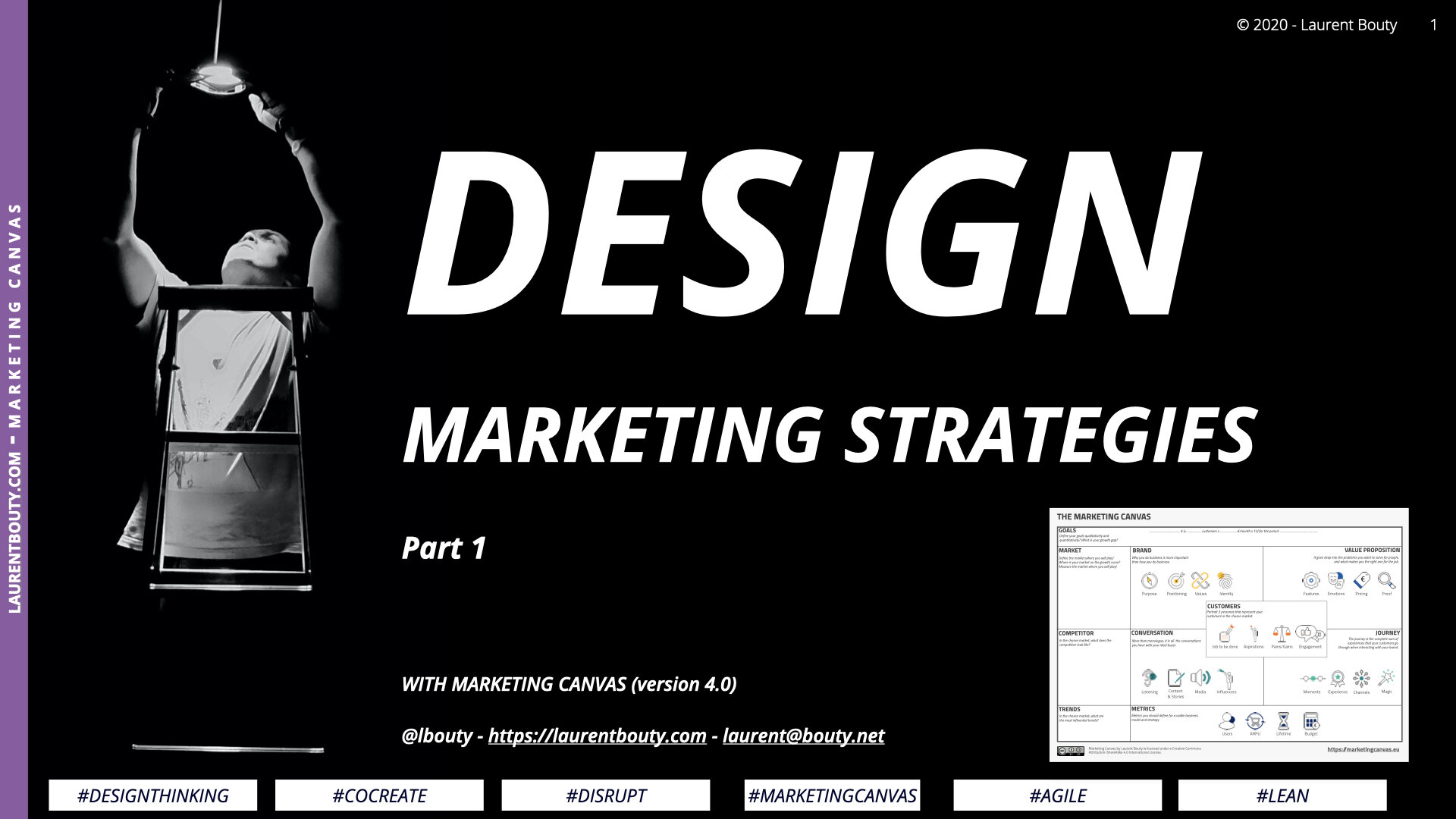Last update: 03/06/2023
Purpose drives firms to find and create new forms of value (Jim Steingel)
In a nutshell
The Marketing Canvas is a tool to build a marketing strategy that consists of six categories, including PURPOSE, which identifies a brand's reason for being and contribution to the world. Purpose-driven brands are more successful in today's world as customers want to engage with brands that align with their values. By starting with the WHY and formulating a purpose-driven brand ideal, businesses can differentiate themselves and build a loyal following. TOMS Shoes and Ben & Jerry's are examples of purpose-driven brands. Having a clear purpose is a key driver of business success, according to a Deloitte survey. It is critical to identify and articulate a brand's purpose to guide its marketing strategy.
In the Marketing Canvas
The Marketing Canvas is a powerful tool for entrepreneurs and non-marketers to build a robust marketing strategy. It consists of six main categories, each with four dimensions, for a total of 24 dimensions defining your Marketing Strategy. One of these dimensions is PURPOSE, which falls under the BRAND category.
How to use it?
In today's world, consumers seek to engage with brands that have a clear and compelling purpose beyond just making a profit. PURPOSE is all about identifying your brand's reason for being and its contribution to the world. It goes beyond profit because that is just a result. A clear PURPOSE means that you can provide an articulated answer to why you are in business.
Simon Sinek's golden circle [1] explains that great leaders and brands always start from the WHY. Having a clear PURPOSE is similar to this concept. By starting with the WHY, you can develop a purpose-driven brand that inspires loyalty and connects with customers on a deeper level.
For instance, Patagonia's purpose is to save the planet by providing high-quality outdoor clothing that is environmentally sustainable.
Jim Stengel [2], a businessman, author, and professor, proposes that having a purpose means that you have clearly identified and formulated a brand ideal for your activity that is the higher benefit your brand gives to the people. This can include eliciting joy, enabling connection, inspiring exploration, evoking pride, and impacting society broadly. Stengel argues that personal inspiration can come from the most trying times, as he shares the story of his brother Bob, a beloved physician known for his compassion and dedication towards his patients.
Eliciting Joy: Activating experiences of happiness, wonder, and limitless possibility
Enabling Connection: Enhancing the ability of people to connect with each other and the world in meaningful ways
Inspiring Exploration: Helping people explore new horizons and new experiences
Evoking Pride: Giving people increased confidence, strength, security, and vitality
Impacting Society: Affecting society broadly, from challenging the status quo to redefining categories
Your brand’s reason for being and contribution to the world. It goes beyond profit because that is a result.
In today's crowded marketplace, having a clear purpose can help your brand stand out from the competition. By identifying a purpose that resonates with your target audience, you can differentiate your brand and build a strong, loyal following. This can help you to outperform your competitors, as customers are increasingly looking for brands that align with their values and beliefs.
According to a survey conducted by Deloitte in 2014 [3], organizations having a strong sense of purpose are much more optimistic about their ability to stay ahead of industry disruptions and to outperform their competition. These organizations understand that a clear PURPOSE is a key driver of business success.
Best practices of purpose-driven companies
Sustainability: Consumers are increasingly demanding that companies take responsibility for their environmental impact. Purpose-driven brands can incorporate sustainable practices into their operations and communicate their efforts to their audience.
Social responsibility: Purpose-driven brands can also make a positive impact on society by supporting social causes, such as poverty alleviation, education, and healthcare. Consumers are more likely to support brands that demonstrate a commitment to social responsibility.
Ethical branding: Purpose-driven brands should ensure that their messaging and practices align with ethical values. This can include using fair labor practices, avoiding exploitative marketing tactics, and being transparent about their operations.
Authenticity: Consumers can easily detect when brands are engaging in purpose-driven marketing for the sake of profit. Purpose-driven marketing must be authentic and align with the brand's values and practices.
Employee engagement: Purpose-driven marketing can also be used to engage employees and build a positive company culture. Companies that prioritize their employees' well-being and work to make a positive impact on society can improve employee satisfaction and retention.
Storytelling: Purpose-driven marketing can be more effective when brands use storytelling to communicate their values and mission. Stories can create an emotional connection with the audience and help to communicate the brand's purpose in a compelling way.
Examples
TOMS Shoes: TOMS Shoes is a great example of a purpose-driven brand. Their purpose is to improve lives by providing shoes, sight, water, and other basic needs to people in need. For every pair of shoes purchased, TOMS donates a pair to a child in need. This purpose has driven their marketing strategy, as they have built a loyal customer base who are inspired by their mission and values.
Ben & Jerry's: Another great example of a purpose-driven brand is Ben & Jerry's ice cream. Their purpose is to make the world a better place, through their commitment to social justice, environmental sustainability, and economic equality. This purpose has driven their marketing strategy, as they have built a loyal customer base who are passionate about their values and mission.
Evaluating and Improving Your Brand's Purpose
To evaluate the effectiveness of your purpose, measure your agreement with the following statements on a scale from -3 (completely disagree) to +3 (completely agree):
You have a well defined and clearly formulated purpose.
Your purpose is very relevant in the company's current and future context, addressing all the influencing trends. `
Your purpose stands out from direct and indirect competitors.
Your main stakeholders are inspired by your purpose, they believe it.
Negative score: An overall negative rating indicates significant weaknesses in your purpose, requiring a thorough review and potential revision to align with stakeholders' expectations.
Neutral score: An overall neutral rating suggests a mixed or average performance in terms of purpose, highlighting areas where improvements can be made to enhance its effectiveness and impact.
Positive score: An overall positive rating signifies a strong purpose that effectively resonates with stakeholders, positioning your brand for success and fostering a sense of belief and inspiration among your audience."
These questions and ratings provide a structured evaluation framework to assess the effectiveness and strength of a brand's purpose.
Conclusion
In conclusion, PURPOSE is a critical dimension of the Marketing Canvas's BRAND category, and it is essential to have a clear and compelling purpose to build a successful brand. By starting with the WHY and formulating a purpose-driven brand ideal, you can create a loyal customer base that connects with your brand on a deeper level. So, take the time to identify and articulate your brand's purpose and let it guide your marketing strategy.
Sources
Simon Sinek, Start with WHY, https://simonsinek.com
Jim Steingel, Purpose, https://www.jimstengel.com/purpose/
Deloitte, 2014, Culture of Purpose (pdf), https://www2.deloitte.com/content/dam/Deloitte/us/Documents/about-deloitte/us-leadership-2014-core-beliefs-culture-survey-040414.pdf
Deloitte, 2022, Unleashing Purpose Across Industries (pdf) https://www2.deloitte.com/content/dam/Deloitte/us/Documents/consulting/us-final-unleashing-purpose-across-industries.pdf





































